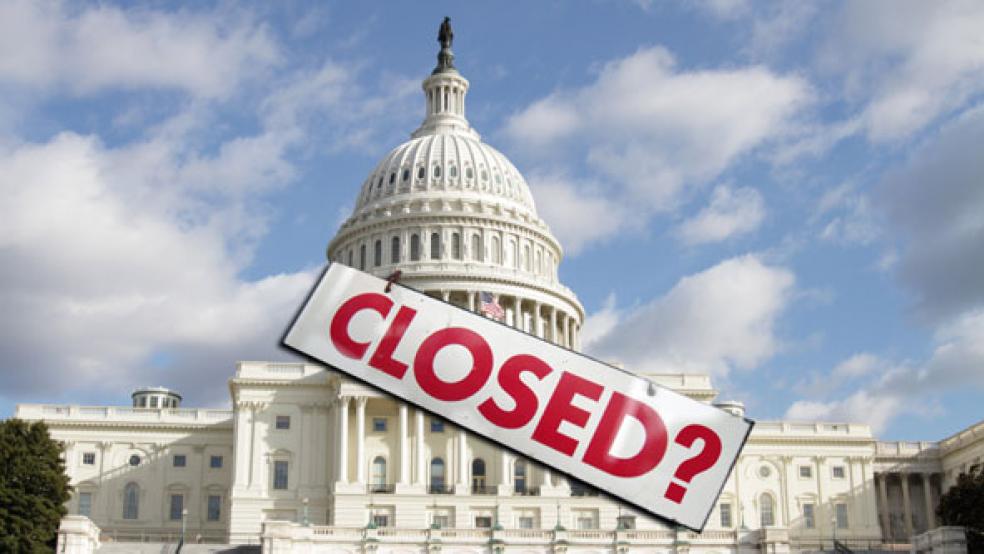This piece was updated on September 26, 2013.
As the possibility of a government shutdown moves into sharper focus with each passing hour, all eyes are on the ways it could hurt everyday Americans.
Back in 1995, when funding for the government expired, non-essential services came to a halt. National parks and museums were closed; passport processing was delayed. Even the National Weather Service cut back on its regular reports.
But in coordination with the Office of Management and Budget, the president has broad discretion over what departments and agencies should be kept open, making it difficult to quantify exactly how much it would cost the government—and how it would affect the public—if a shutdown were to happen.
RELATED: CRUZ GETS SUPPORT FROM A GOP SHUTDOWN VETERAN
“Although a government shutdown would be disruptive, the impact will depend on the duration and the degree, on how tight or loose the exceptions are,” Patrick O’Keefe, director of economic research at J. H. Cohn and a former Deputy Assistant Secretary in the U.S. Department of Labor, said in 2011, when another shutdown loomed. “But the bigger impact is its demonstration of political impasse regarding the country’s unsustainable fiscal posture... The financial market implications of such an impasse should not be underestimated.”
“I don’t think there is a full appreciation of the impact of a shutdown on the bottom line of government,” said Max Stier, president and CEO at the Partnership for Public Service, a nonpartisan think tank. “Most agencies are ill prepared for the disruption.”
A significant majority of Washington budget and policy experts surveyed by The Fiscal Times in 2011 said they expected a government shutdown of at least a few days after the latest stop-gap spending measure expires. (A shutdown was narrowly avoided that year.)
If a shutdown does occur this time around, it would inconvenience the public in ways large and small. Consider some of the impacts of the three-week shutdown back in 1995-1996—all of which could be repeated this time around:
1. New patients were no longer accepted into clinical research at the National Institutes of Health. In addition, NIH disease hotlines and CDC disease surveillance were stopped.
2. Work on more than 3,500 bankruptcy cases in the federal court system was suspended.
3. Hundreds of thousands of “non-essential” federal workers were furloughed for three weeks, from mid-December 1995 to early January of 1996. (Some of those workers eventually received back pay for their missed days.)
4. Of $18 billion in Washington, D.C., area federal contracts, $3.7 billion (over 20 percent) were affected adversely by the funding lapse.
5. Some 368 National Park Service sites closed — a loss of 7 million visitors. The National Park Service administers 84.4 million acres of federal land in 49 states and other federal territories.
6. National museums and monuments closed, including the Smithsonian and other government buildings, with an estimated loss of about 2 million visitors.
7. Over 600 toxic waste dump sites went untended and uncleaned during the last shutdown. Some 2,400 Superfund employees did not work.
8. The recruiting and testing of new law enforcement officials – including 400 Border Patrol agents – were suspended.
9. During the last shutdown, 20,000 to 30,000 applications for visas by foreigners went unprocessed each day, along with 200,000 applications for U.S. passports. Airlines also suffered: Many prospective travelers were unable to fly.
10. The Department of Veterans Affairs had to cut many of its services, including health care, welfare, travel, and finance; the department could not process compensation claims.
11. The shutdown in 1995 meant a delay in processing alcohol, tobacco, firearms, and explosives applications by the Bureau of Alcohol, Tobacco, and Firearms (ATF).
12. The National Weather Service did not produce its regular reports during the 1995-1996 shutdown.
13. New Social Security claims were not processed because the agency furloughed over 61,000 employees. As the shutdown continued, the agency regrouped, recalling workers to start processing new claims again.
It’s clear that government shutdowns can be nasty business: They’ve required the cessation or the reduction of government activities and affected all sectors of the economy, according to a report by the Congressional Research Service.
RELATED: BOEHNER SHIFTS TO DEBT CEILING GAME PLAN
Former House Speaker Newt Gingrich was one of the architects of the 1995 government shutdown which lasted 21 days. It was settled when President Clinton submitted a budget that proposed to eliminate the federal deficit in seven years, according to Time magazine.
The issues that were presented then and ultimately triggered the 1995 shutdown were the same as in 2011 and eerily similiar to 2013 as well. June O’Neill, who was CBO director in 1995, says that Congress couldn’t agree on a budget resolution for the coming year and was haggling over whether to raise the debt ceiling in 2011. The economy was also recovering from the 1991 recession and growth was sluggish, which is also similar to today. “There was a great deal of posturing then as there is now,” O’Neill recalled in 2011. “The world would come to an end if the debt ceiling wasn’t raised.”
But in 1995, it was more about Gingrich proving he was just as powerful as the Clinton administration, she said.





